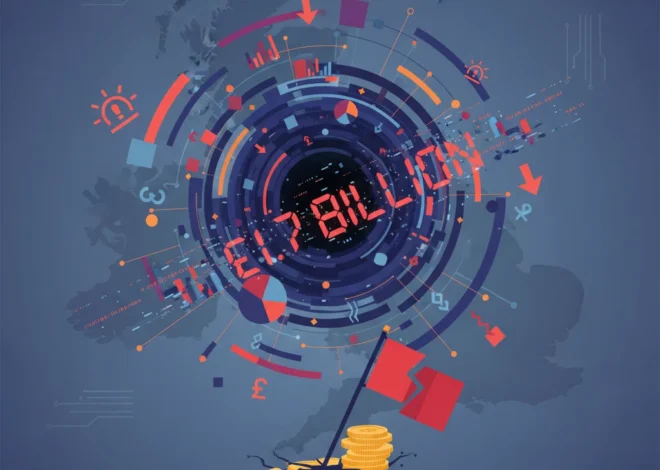
Beyond the Iceberg: What the Titanic Teaches Us About Modern Investing and Fintech
More than a century after its ill-fated maiden voyage, the RMS Titanic remains lodged in our collective consciousness, a ghost ship sailing through the seas of history and popular culture. The story’s power is so enduring that new virtual-reality experiences are now inviting people to step aboard its decks, to feel the chill of the Atlantic air and witness the grandeur before the fall (source). But beyond the cinematic romance and the chilling human drama lies a powerful and surprisingly relevant allegory for the world of modern finance, investing, and the global economy.
The Titanic was not just a ship; it was a symbol of an era’s technological prowess, industrial ambition, and, most critically, its hubris. It was marketed as “unsinkable,” a monument to human ingenuity that, in the minds of many, had conquered the perils of nature. This narrative of infallibility is one that should sound eerily familiar to any student of financial history or participant in today’s stock market. The story of the Titanic is a masterclass in risk management failure, the dangers of hype, and the devastating financial consequences that follow when overconfidence collides with reality.
In this analysis, we will delve into the financial wreckage of the Titanic, exploring the timeless lessons it offers for today’s investors, business leaders, and fintech innovators. From the psychology of market bubbles to the role of regulation and the emergence of new economic models, the ship’s tragic story is a case study that continues to pay dividends in wisdom.
The “Unsinkable” Portfolio: Hubris, Hype, and a Failure of Risk Management
The core of the Titanic’s legend is the claim of its invincibility. Built by Harland and Wolff for the White Star Line, it was the largest ship afloat, a marvel of engineering. This confidence was so absolute that it led to a catastrophic failure in risk management: the ship carried only enough lifeboats for 1,178 people, roughly half of the 2,224 souls on board. The rationale was that the ship itself was the ultimate lifeboat. This wasn’t just an oversight; it was a calculated decision rooted in an unshakeable belief in the system’s perfection.
This is the very essence of a market bubble. Whether it’s the dot-com boom of the late 1990s, the subprime mortgage crisis of 2008, or the more recent speculative frenzies in certain cryptocurrencies, the narrative is always the same: “This time is different.” Investors pile into an asset class, convinced of its unsinkable nature, ignoring fundamental valuations and dismissing cautionary voices. The “lifeboats”—diversification, stop-loss orders, and rigorous due diligence—are deemed unnecessary in the face of seemingly guaranteed returns. This psychological trap, known in behavioral economics as “overconfidence bias,” is one of the most destructive forces in investing.
The financial backing for the Titanic came from the International Mercantile Marine Company (IMM), a shipping trust financed by the legendary J.P. Morgan. The project was a massive capital undertaking, a bet on the burgeoning transatlantic passenger trade. For investors in IMM, the Titanic was a blue-chip asset, the crown jewel of a dominant player in a growing market. Its failure was not just a tragedy but a “black swan” event—an unforeseen and catastrophic risk that wiped out immense value and sent shockwaves through the banking and insurance industries. The lesson for modern finance is stark: no single asset, company, or technology is too big to fail. Prudent investing requires preparing for the iceberg you don’t see coming.
The Economic Fallout: Charting the Financial Wreckage
The sinking of the Titanic on April 15, 1912, was an immediate financial cataclysm. The direct economic losses were staggering for the era. The ship itself was valued at approximately $7.5 million in 1912, which translates to over $200 million today (source). This asset was instantly wiped off the balance sheet of IMM, whose stock plummeted on the stock market in the following days. The human cost also carried a grim economic toll, with many of the victims being prominent business leaders and wealthy industrialists, representing a significant loss of capital and intellectual leadership.
The insurance industry faced one of its largest claims in history. Lloyd’s of London, the famous insurance market, had underwritten a significant portion of the ship’s hull insurance. While the total payout of around £1 million (about $5 million at the time) was a massive sum, the loss was spread across a syndicate of underwriters, a foundational principle of insurance that prevented any single entity from collapsing. This was a testament to a more robust risk-sharing model than the one employed by the ship’s designers. The event underscored the critical role of insurance and reinsurance in maintaining the stability of the global economy in the face of disaster.
To put the financial lessons into a modern context, we can draw direct parallels between the failures aboard the Titanic and common pitfalls in today’s financial landscape.
| Titanic’s Failure | Modern Financial Parallel |
|---|---|
| Belief in the “unsinkable” ship | Overconfidence in “too big to fail” institutions or “sure-thing” stocks |
| Insufficient lifeboats (poor risk mitigation) | Lack of portfolio diversification; concentrated bets without hedging |
| Ignoring iceberg warnings (dismissing data) | Ignoring market indicators, expert warnings, or red flags in a company’s financials |
| High speed in a known ice field (excessive risk-taking) | High-leverage trading or chasing short-term gains without regard for long-term risk |
| Class-based access to lifeboats | Information asymmetry and unequal access to investment opportunities in the market |
From Regulation to Virtual Reality: A New Economy of Experience
The sinking of the Titanic was a catalyst for monumental change in maritime safety. The disaster led directly to the first International Convention for the Safety of Life at Sea (SOLAS) in 1914, which mandated lifeboat requirements, 24-hour radio watches, and the establishment of an international ice patrol. In essence, a catastrophic market failure led to the creation of a robust regulatory framework to protect all future participants.
This cycle of crisis-followed-by-regulation is a cornerstone of financial history. The 1929 stock market crash led to the Glass-Steagall Act and the creation of the SEC. The 2008 financial crisis gave rise to the Dodd-Frank Act. Each “sinking” forces the system to evolve, plugging the vulnerabilities that were ignored during the boom times. This is a crucial function of economics and government in a functioning capitalist society—to create guardrails that prevent systemic collapse without stifling innovation.
And innovation continues. Today, the legacy of the Titanic is being monetized in entirely new ways, driven by cutting-edge technology. The virtual-reality experiences mentioned in the Financial Times article represent a fascinating intersection of history, entertainment, and commerce (source). This is part of the burgeoning “Experience Economy,” where consumers pay not for goods, but for memorable, often immersive, events. For investors, this represents a new and growing asset class. Companies that can successfully blend storytelling with technology are creating powerful new revenue streams. The financial technology, or fintech, that underpins these ventures—from digital ticketing platforms to in-experience microtransactions—is creating a new infrastructure for how we consume culture.
The Paradox of Prudence: Is the UK's Fiscal Watchdog Stifling Economic Growth?
One could even imagine a future where blockchain technology plays a role. Think of a verified, limited-edition VR walkthrough of the ship’s first-class suites, with ownership of that digital experience recorded as a non-fungible token (NFT). This might seem futuristic, but it’s a direct extension of the principles of scarcity and value that have always driven markets. The Titanic, a symbol of the peak of the industrial economy, is now becoming a digital asset in the 21st-century information economy.
Conclusion: Navigating the Waters Ahead
The story of the Titanic endures not just because of the scale of the tragedy, but because it is a profoundly human story of ambition, love, loss, and failure. Yet, its most lasting legacy may be the powerful lessons it provides for navigating our complex modern world. For those in finance, banking, and investing, it is a permanent reminder that hubris is the most dangerous liability on any balance sheet.
It teaches us to question narratives of infallibility, to prioritize robust risk management, and to understand that the most significant threats are often the ones we dismiss or cannot see. As financial technology continues to evolve, creating new vessels of wealth and new methods of trading, the fundamental principles remain. Every investor and business leader must ask: Have we checked for icebergs? And more importantly, do we have enough lifeboats?
HMRC's Crypto Crackdown: What Every UK Investor Needs to Know


